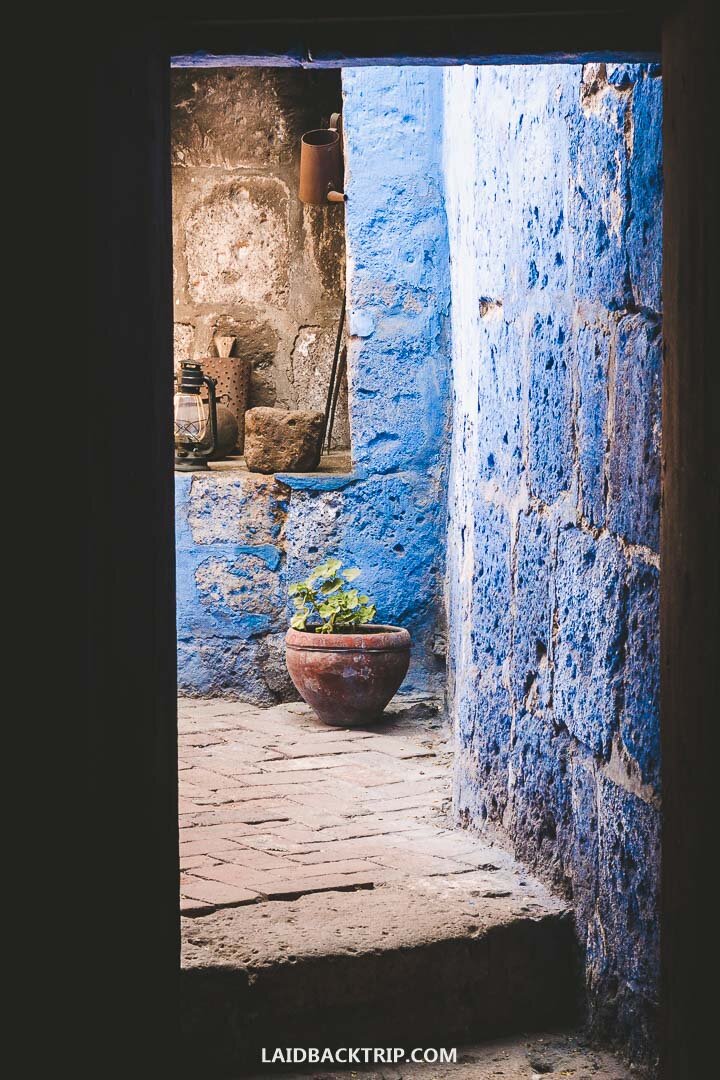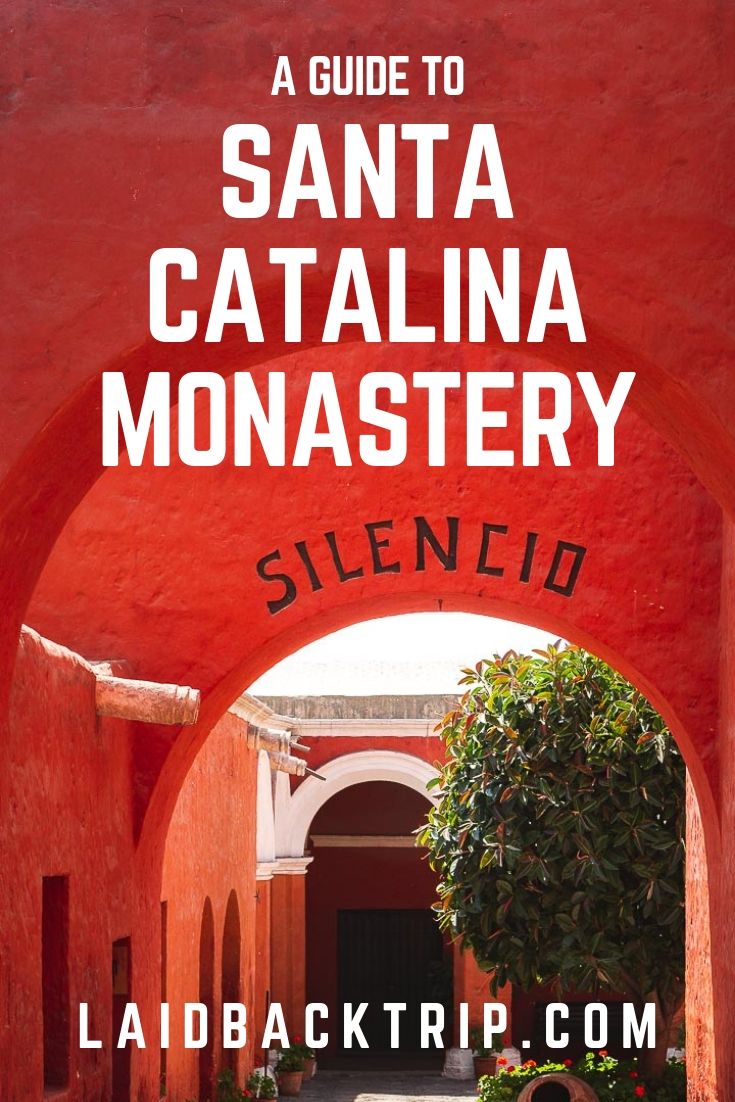A Guide to Santa Catalina Monastery, Arequipa
Arequipa is one of the most beautiful colonial cities in Peru, but not every traveler knows that except for exploring the old town, climbing the volcanoes, and hiking in the Colca Canyon, one of the best things to do in the city is visiting Santa Catalina Monastery. The place is incredibly photogenic, so get inspired by our photo guide to the red and blue city of Santa Catalina Convent.
Arequipa, a must-visit destination which is on every traveler's Peru itinerary, is often nicknamed the White City because the buildings that line Plaza de Armas and overall the architecture you can see in the historic center is made of a white volcanic rock called sillar.
But once you enter Santa Catalina Monastery, a city within a city, you will have a feeling that you've emerged in a completely different world made of vivid red and blue colors.
Santa Catalina Monastery, officially Monasterio de Santa Catalina de Siena, was one of the most photogenic places we've seen in South America.
That's why we have decided to create this photo guide to show you the best the walled city has to offer, ignite your wanderlust and inspire you to visit this extraordinary place.
It does not matter if you have only a couple of hours to spend in Arequipa, or if you travel long term, visiting Santa Catalina Monastery is one of the must-do activities in Arequipa, which you should not miss by no means.
Here's our travel guide, that except for our favorite photos, includes a brief history of Santa Catalina Monastery, things you can expect to see, and visitors' information such as opening hours and ticket prices.
HISTORY & FACTS
Santa Catalina Monastery was founded in the late 16th century, in 1579 to be precise, by a wealthy widow from Arequipa, Maria de Guzman.
For almost 400 years, very little people knew how the monastery looks like behind its walls, as it was opened to the public in 1970.
From the very beginning, only wealthy women were accepted to the monastery as their families had to pay a high dowry (nowadays it would have been equivalent to $150 000), usually hoping to erase their sins.
The monastery survived several earthquakes, so it is quite surprising how intact it looks. At the city's peak, around 400 nuns lived here.
When a young lady entered the monastery, she could never leave its walls (she could leave when she was in her trial, but she would have caused a terrible disgrace to her family).
During the trial, which took several months, a young nun could not speak with anyone, but later she was allowed to have a house even with servants.
So except for the fact women could not walk outside and had a strict regime, they lived in luxury, which was so obvious that pope Pius IX ordered to reform Santa Catalina Monastery and told them to get back to the roots.
Nowadays, only 20 nuns live in the monastery, but they require privacy, and you won't most likely be able to see them during your visit as the part where nuns live is not accessible.
THINGS TO SEE AND DO IN SANTA CATALINA MONASTERY
Once we entered the monastery, we instantly felt that we were transported to a quiet, isolated world far away from the bustling city center of Arequipa.
The monastery is made of narrow streets lined with red, blue, yellow, and white houses, which created a photogenic collage attacking our senses, and it almost seemed unbelievable that places like this still exist.
From time to time, we emerged on a small plaza with a fountain, or we decided to walk inside the houses (most of them are renovated and accessible), so we could get an idea of how nuns lived centuries ago.
It must be said that some houses which belonged to wealthier nuns were real mansions with large living rooms, kitchen, and a room for a servant - not bad at all.
We could even see a garden, laundry system, or a bath (most of the nuns had their own toilet, but the bath was only one in the center of the monastery).
When you get a chance, do not miss a small courtyard with several stone steps leading to the roof from where you'll get an amazing view of the volcanoes around Arequipa.
What we liked the most about our Santa Catalina Monastery visit was how intuitively we could wander around, how, despite its popularity, all those hidden plazas and nooks felt, and how peaceful the whole experience was.
Santa Catalina Covent is certainly a place that will help you to forget your everyday problems and transfer you far away.
WHERE TO STAY IN AREQUIPA
You won't have a problem finding a room in Arequipa, as it is the second biggest city in Peru, but book your accommodation well in advance, especially when you travel in the country during the high season from April to October.
We've handpicked the three best hotels in Arequipa for every budget.
Budget | Holidays Hostel Arequipa - Cheap, centrally located hostel offers breakfast, comfortable rooms, and wifi works well, and overall you'll get a perfect price/quality ratio. You can also book your Colca Canyon tour here.
Mid-range | Casa de Avila - Only 400 meters from Arequipa's main square, this hotel is the real gem for the price. It has its own central garden, where you can escape the hustle and bustle of the city.
Luxury | Casa Andina Premium Arequipa - This hotel is a real treat for those who can splurge. Situated in the White City center, this colonial mansion was turned into a hotel with a soul, and the traditional furniture and courtyards are the highlights here.
ENTRANCE FEE
Visiting Santa Catalina Monastery is a bit pricey by Peruvian standards, but in our opinion, it is worth every penny.
The Santa Catalina Monastery entrance ticket costs S/.40 per person, which is quite a lot, but on the other hand, the monastery is a true architectural gem, and despite the fact we were traveling on a budget, we did not mind at all to contribute for repairs a bit.
Locals but also foreigners age 7 to 20 have a discount, so ask at the counter.
GUIDED TOUR
Once you buy the ticket and enter the monastery, you can choose whether you want to explore the city independently or with a guide.
We opted for the guided tour to learn more about history, and glad we did.
An hour-long guided tour in English costs S/.20 for a small group - we met two Australian guys in front of the entrance, and they were willing to share the cost with us, which was great as we were traveling on a budget.
So, first, we took the guided tour, and followed the local guide in order to learn more about Santa Catalina Monastery. The guide was very informative and spoke very good English; unlike the guide on our Colca Canyon day tour.
After the tour, we roamed this incredible place independently, and retraced our steps with our travel camera in hands.
And this is also one of the main reasons why we loved our time at the monastery so much.
OPENING HOURS
Opening hours and rules change quite often in Peru, so it is always better to check out the current rules on the spot, but according to our latest information, Santa Catalina Monastery's opening hours are following.
Santa Catalina Monastery is opened Monday to Saturday from 10 AM to 5 PM, and the last entry is allowed at 4 PM.
The monastery is closed on Sunday (again, ask around), but do not despair; there are so many things to see and do in Arequipa that you can always leave your visit for the next day.
The monastery is traditionally closed on Good Friday, December 25, and January 1.
The convent is easily accessible, and you can get there on foot from the city center.
Travel Insurance
We never leave home without travel insurance that was designed to cover our expenses if something goes wrong during the trip.
Travel insurance protects against theft, flight delays, injury, illness, cancellations, and much more.
World Nomads provides travel insurance for travelers to cover their trip essentials, including sports and adventure activities.
SafetyWing is affordable travel insurance for backpackers, long-term travelers, and digital nomads.
Travel smarter and safer!
Travel Resources
Here you can find links to all the travel resources we use and which you might find helpful when planning your next holiday.
Accommodation: When looking for accommodation, we usually search hotels via Booking.com or Hostelworld.
Tours: Although we love to travel independently, some places are better to visit with a guided tour.
We prefer GetYourGuide for its easy-to-use interface and solid reputation. Another great alternative is Viator.
Rental Cars: When going on a road trip, we always use Rentalcars.com, a reliable site for booking a rental car in advance.
Flight Tickets: When looking for flight tickets, you can search Skyscanner to find the best price.
Travel Insurance: World Nomads and SafetyWing cover against risks of travel.















